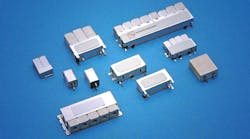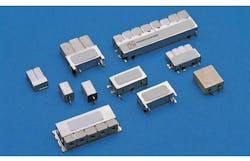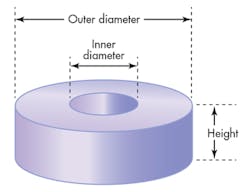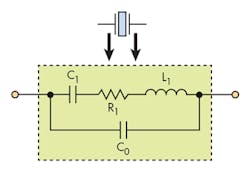1. These ceramic resonators can be used in applications spanning 200 MHz to 10 GHz. (Courtesy of Integrated Microwave Corp.)
Resonators are key to the performance of a range of RF/microwave components, such as oscillators and filters. The types of available resonators include coaxial, dielectric, crystal, ceramic, surface acoustic wave (SAW), and yttrium iron garnet (YIG). Given this variety, it is essential for designers to understand the characteristics of the various resonators.
Coaxial Resonators
Coaxial resonators are commonly used to design components like voltage-controlled oscillators (VCOs), coaxial-resonator oscillators (CROs), and filters. This form of resonator is essentially a ceramic coaxial line. Often, coaxial resonators are implemented in oscillators as high-quality-factor (high-Q) inductors, thereby creating a resonant circuit when paired with a capacitor or varactor diode. A coaxial resonator has an outer conductor with an approximately square-shaped cross-section and a cylindrical center conductor.
Coaxial resonators have two different forms: a quarter-wavelength (λ/4) resonator with one end shorted and the opposite end open; and a half-wavelength (λ/2) resonator with both ends open.
Because a coaxial resonator’s material has a high dielectric constant (εr) value, components designed with them can be reduced in size. Typical εr values range from 10 to 100.
Ceramic coaxial resonators are offered by companies like Integrated Microwave Corp. (Fig. 1). These resonators are intended for a range of applications, including oscillators, bandpass/bandstop filters, and electromagnetic-interference (EMI) filtering. They can be used to satisfy frequency requirements ranging from 200 MHz to 10 GHz. Customers can select from nine different sizes, which range from 2 to 18 mm. In addition, IMC offers the resonators in five different materials.
For its part, Trans-Tech offers a line of coaxial resonators that are intended to serve as ceramic coaxial line elements. They are available in seven sizes and four εr values. The company offers these resonators for applications that span from ultra-high frequency (UHF) to 6 GHz.
Ceramic coaxial resonators are also offered by Tusonix. The company offers these products in four sizes and four εr values. They cover 800 MHz to 5.9 GHz. Their intended applications include oscillators, filters, and duplexers.
Meanwhile, Temex Ceramics offers a product line of coaxial resonators intended for telecommunications, military and space, industrial, and wireless applications. The resonators are offered for applications from 300 MHz to 6 GHz. In addition, selections can be made from different sizes along with several εr values.
Dielectric Resonators
A dielectric resonator can be used to replace resonant cavities in components, such as filters and oscillators. It is typically a disc-shaped material with a high εr value. This high εr value provides a significant advantage, enabling the size of a circuit designed with a dielectric resonator to be significantly smaller than when an air-filled cavity resonator is employed. Electromagnetic fields are largely confined within a dielectric resonator, allowing radiation losses to be extremely small and a high quality-factor (Q) to be achieved (Fig. 2).
Although a dielectric resonator will resonate in several modes, the TE01δ (transverse-electric) mode is most commonly used in many applications. When operating in this mode, a dielectric resonator may be magnetically coupled to a circuit by several different methods. One method is to couple the resonator to a microstrip line. This approach can be used to create components like dielectric-resonator oscillators (DROs).
2. This illustration represents a typical disc-shaped dielectric resonator.
One company offering dielectric resonators is MCV Microwave. These components are typically used in oscillators, satellite-based communication equipment, microwave filters, and combiners. They can be selected for applications spanning 260 MHz to 26 GHz.
In addition to their line of coaxial resonators, Temex Ceramics offers a selection of dielectric resonators. They are intended to be used for applications like telecommunication infrastructures, alarms/detection, military and space, and automotive. The resonators cover 800 MHz to 50 GHz. They are available in six different materials.
Dielectric resonators are also offered by Trans-Tech for both commercial and military applications. Among their applications are cellular base station filters and combiners, direct broadcast satellite (DBS) receivers, and motion detectors. They are intended for applications ranging from below 850 MHz to above 32 GHz.
Crystal Resonators
Quartz crystals can be used as high-quality electromechanical resonators. Their piezoelectric properties allow them to be used as frequency-control elements in crystal oscillators. Quartz crystals offer high Q and superior frequency stability. In fact, their high Q is the main reason why crystal oscillators are often employed instead of LC oscillators.
Piezoelectric materials have the capability to convert mechanical energy into electrical energy and vice versa. When a mechanical stress is applied, an electric charge is generated. This electric charge is proportional to the applied mechanical stress. The same material becomes strained when an electric field is applied.
In a quartz crystal resonator, a thin slice of quartz is placed between two electrodes. This quartz slice is obtained by cutting the original material at specific angles in regard to the various axes, which determines the resonator’s physical and electrical parameters. Thus, a quartz crystal can be classified by the manner it was cut from the original material. Resonators can be generated from a variety of cuts, such as the widely used AT- and SC-cuts.
According to IQD Frequency Products, when the frequency of an applied voltage approaches one of the mechanical resonance frequencies of the quartz slice, the amplitude of the vibrations becomes very large. The accompanying displacement current also increases, which decreases the magnitude of the device’s effective impedance. Thanks to the impedance’s rapid change as the frequency varies near resonance, quartz crystal resonators can be used as frequency-control elements in crystal oscillators.
Near a resonant frequency, a quartz crystal can be represented by an equivalent electrical circuit (Fig. 3). C0 represents the shunt capacitance of the electrodes in parallel with the holder capacitance. L1 is the electrical equivalent of the critical mass, while C1 represents the crystal stiffness or elasticity. R1 represents heat loss due to mechanical friction.
As an example, IQD Frequency Products offers a range of quartz crystals spanning 10 kHz to 250 MHz with frequency stability as low as ±5 ppm. High-specification AT-cut quartz crystals are also offered, providing a fundamental mode frequency from 10 to 42 MHz. In addition, the company offers crystals for automotive applications.
Crystek also offers a range of quartz crystals in various packaging options from 1.8432 to 150 MHz. Among the additional suppliers of crystal resonators are Vectron, Murata, Oscilent, and Abracon, to name a few. Murata, for example, claims that its crystals can be used for communication satellites, mobile communication devices, automotive electronics, TVs, personal computing, and home information appliances.
Ceramic Resonators
Ceramic resonators are a viable alternative to quartz crystals. Although they are less accurate than quartz crystals, ceramic resonators do offer other benefits. For instance, they can be manufactured in smaller packages and at lower costs. In addition, they provide a lower start-up time than quartz crystals.
3. This electrical circuit represents a quartz crystalâs electrical equivalent near a resonant frequency.
Ceramic resonators utilize the mechanical resonance of piezoelectric ceramics, such as lead zirconium titanate (PZT). Two metal electrodes are evenly placed on both the top and bottom of the ceramic substrate. When a voltage is applied, the substrate vibrates between the electrodes. The resonant frequency is determined by the substrate’s thickness. A ceramic resonator’s equivalent electric circuit is identical to a quartz crystal. Because its operation is similar to a crystal, it can be used in the same oscillator configurations.
For example, Murata offers the CERALOCK Series ceramic resonators. These products are intended for a range of applications including automotive electronics, communications, personal computing, and medical/healthcare equipment. Other suppliers of ceramic resonators include Oscilent and Abracon.
Saw Resonators
A surface acoustic wave (SAW) that is propagating at the surface of a piezoelectric crystal can be used to carry information. A basic SAW resonator consists of an interdigital transducer and two grating reflectors, which are fabricated on a piezoelectric material by a photolithographic process. The reflectors form a resonant cavity, which the transducer couples to the external circuit. Like crystal resonators, SAW resonators can be used to build oscillators—often in higher-frequency applications. They can also be used to build bandpass filters, such as those offered by Qorvo, Phonon, and Vectron, to name a few. The crystal resonator’s equivalent LC circuit takes the same form. Automotive remote-keyless-entry (RKE) devices, security systems, and garage door openers are some examples of consumer products that commonly use SAW resonators.
As an example, ECS Inc. International offers a variety of SAW resonators. They are available in both surface-mount and through-hole packages. The company offers these SAW resonators for wireless security and remote control applications.
A portfolio of SAW resonators from Murata spans 300 MHz to 1 GHz while achieving center frequency tolerances as low as ±50 kHz. The resonators are available in a variety of packages. In addition, Abracon offers a line of SAW resonators covering 117.2 to 916.5 MHz. These products are intended for applications like wireless remote controllers and mobile communications. They are available in both surface-mount and through-hole packages. Lastly, a range of SAW resonators covering 100 MHz to 1.1 GHz is offered by Golledge Electronics. The products are available in a variety of packages. In addition, custom specifications are available.
YIG Resonators
Yttrium iron garnet (YIG) resonators can be used to design oscillators and filters. A YIG is a crystal that has a very high Q, enabling oscillators to be designed with very low phase noise. Multi-octave bandwidths are another benefit than can be achieved by using YIG resonators.
YIGs are most often used in a sphere configuration. However, other shapes have also been used over the years. A YIG will resonate at microwave frequencies when it is immersed in a direct-current (DC) magnetic field. This resonance is directly proportional to the strength of the applied magnetic field, which is generated using an electromagnet, a permanent magnet, or a combination of both.
A number of YIG-based products are offered by Micro Lambda Wireless. That company’s YIG-tuned oscillators cover 500 MHz to 44 GHz with output power levels that range from 0 to +23 dBm. The company also offers a line of YIG-tuned filters that span 500 MHz to 50 GHz.
In summary, a wide range of resonators is available from a plethora of suppliers. With many potential applications, it is important to have an understanding of the different varieties and how they can be implemented in a design. Each type of resonator is well suited for different applications, which prompts the need to understand the performance characteristics offered by each resonator type.



